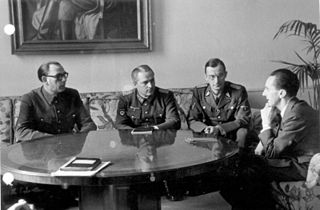 W
WThe 1st Cossack Cavalry Division was a Russian Cossack division of the German Army that served during World War II. It was created on the Eastern Front mostly out of Don Cossacks already serving in the Wehrmacht, those who escaped from the advancing Red Army and Soviet POWs. In 1944, the division was transferred to the Waffen SS, becoming part of the XV SS Cossack Cavalry Corps, established in February 1945. At the end of the war, the unit ceased to exist.
 W
WThe Armenian Legion was a military unit in the German Army during World War II. It primarily consisted of Soviet Armenians, who wanted to fight the Russians for an independent Armenia and commanded by General Drastamat Kanayan.
 W
WThe Brandenburgers were members of the Brandenburg German special forces unit during World War II.
 W
WHiwi, the German abbreviation of the word Hilfswilliger or, in English, auxiliary volunteer, designated, during World War II, the member of different kinds of voluntary auxiliary forces made up of recruits indigenous to the territories of Eastern Europe occupied by Nazi Germany. Adolf Hitler reluctantly agreed to allow recruitment of Soviet citizens in the Rear Areas during Operation Barbarossa. In a short period of time, many of them were moved to combat units.
 W
WThe Legion of French Volunteers Against Bolshevism was a unit of the German Army (Wehrmacht) formed by collaborationist volunteers from Vichy France to participate in the German invasion of the Soviet Union in 1941. It was officially designated the 638th Infantry Regiment and was among a number of similar formations recruited in German-occupied Western Europe at the time.
 W
WThe Nachtigall Battalion, also known as the Ukrainian Nightingale Battalion Group, or officially as Special Group Nachtigall, was the subunit under command of the German Abwehr special operations unit Lehrregiment "Brandenburg" z.b.V. 800. Along with the Roland Battalion it was one of two military units formed February 25, 1941 by head of the Abwehr Wilhelm Franz Canaris, which sanctioned the creation of the "Ukrainian Legion" under German command. It was composed of volunteer Ukrainians operating under Stephan Bandera's Organization of Ukrainian Nationalists (OUN) orders.
 W
WNon-Germans in the German armed forces during World War II were volunteers, conscripts and those otherwise induced to join who served in Nazi Germany's armed forces during World War II. In German war-time propaganda those who volunteered for service were referred to as Freiwillige ("volunteers"). At the same time, many non-Germans in the German armed forces were conscripts or recruited from prisoner-of-war camps.
 W
WRemembrance Day of the Latvian Legionnaires, often known simply as Legionnaire Day or March 16 in Latvia, is a day when soldiers of the Latvian Legion, part of the Waffen-SS, are commemorated. From 1998 until 2000, it was officially recognized as a "Remembrance Day for Latvian soldiers" by the Saeima.
 W
WThe Serbian Volunteer Corps, also known as Ljotićevci, was a fascist militia; the military branch of Zbor, a collaborationist anti-Partisans and anti-Chetniks organization, raised in German occupied Serbia during World War II.
 W
WThe Slovak Expeditionary Army Group was an element of the military forces of the Slovak Republic that fought under Nazi German command on the Eastern Front during World War II.
 W
WAmong the approximately one million foreign volunteers and conscripts who served in the Wehrmacht and Waffen SS during World War II were ethnic Germans, Belgians, Czechs, Dutch, Finns, Danes, French, Hungarians, Norwegians, Poles, Portuguese, Swedes, and British, along with people from the Baltic states and the Balkans. At least 47,000 Spaniards served in the Blue Division.